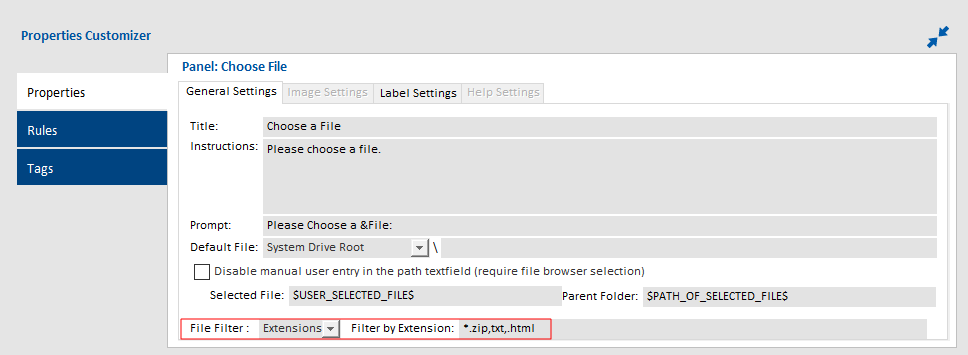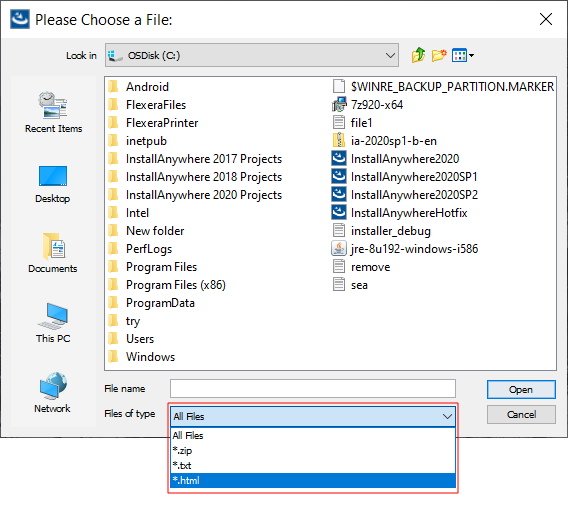Panel Actions
InstallAnywhere 2025 R2
The following table lists the panel actions available in InstallAnywhere.
|
Action |
Description |
||||||||||||
|
The Choose Alias, Link, Shortcut panel action enables end users to choose an installation location for shortcuts (Windows), aliases (OS or OS X), and links (UNIX). This panel action is included in new projects by default. |
|||||||||||||
|
The Choose Database Connection panel action enables end users to specify information for connecting to a database. |
|||||||||||||
|
This panel enables end users to select which features they want to uninstall. |
|||||||||||||
|
The Choose File panel action lets end users select a file; it uses the file name and the path to the file as the values of InstallAnywhere standard variables. You can use these variables elsewhere in your installer. Additionally, you can configure the Choose File panel to filter the files by specific type. The configurable filter options are:
Extensions value will be listed under File of Type along with All Files at runtime. The extension selected will filter files with same extension in the provided path.
|
|||||||||||||
|
The Choose Folder panel action lets end users select a folder; it uses the folder as the value of an InstallAnywhere standard variable. You can use these variables elsewhere in your installer. |
|||||||||||||
|
The Choose Install Folder panel action lets end users choose the primary installation folder. If you omit this panel, the Default Install Folder settings in the Platforms view on the Project page apply. This panel action is included in new projects by default. |
|||||||||||||
|
The Choose Install Sets panel action enables end users to specify which install set or features they want to install. |
|||||||||||||
|
The Choose Java VM panel action lets end users select which Java VM to use for any installed LaunchAnywhere launchers. |
|||||||||||||
|
The Choose Uninstall Type panel action enables end users to select whether to uninstall all or part of the application. |
|||||||||||||
|
InstallAnywhere’s custom code API enables you to create custom panels where necessary. Note:For information on the support of signed JARs as dependencies, see Support for Signed JARs as Dependencies. |
|||||||||||||
|
The Disk Space Check panel action performs a disk space check on the installation destination system based on the end user’s chosen install location and the end user’s chosen features. If there is not enough disk space to perform the install, the installer prompts the end user to free the required disk space or choose another install location. Note:This action is automatically added before files are installed. The action does not appear in the list. |
|||||||||||||
|
The Display HTML panel action displays HTML from an archived file or a specific URL on a panel during the installation. |
|||||||||||||
|
The Display Message panel action lets you display a text message to end users during the installation. This can be useful for conveying information about installation choices that the end user has made. This panel is also particularly useful in debugging installer issues with InstallAnywhere variables. |
|||||||||||||
|
The Find File/Folder panel action implements a search process that searches portions of the file system for a specific file or for a file that matches a certain pattern. The end user can also choose a matching file. |
|||||||||||||
|
The Get Password panel action lets end users enter a password. You can choose to validate the password against a list of specified passwords (enabling the index feature that allows different passwords to effectively unlock different features), or you can store the entered password in a variable (as when requesting a password to be used in a configuration routine). The installer automatically encrypts password values according to the security settings that are specified in the Variables view on the Project page. |
|||||||||||||
|
Implementing InstallAnywhere’s built-in serial number verification and creation routines, the Get Serial Number panel action enables you to add serial number functionality to the installer. You can choose to generate any number of serial numbers for any number of products. Serial numbers can represent unique products or sets of products. The action enables you to create rules that can manage all aspects of the installation based on rights that are granted by the serial numbers that end users enter. |
|||||||||||||
|
The Get User Input - Advanced panel action enables you to get input from end users using multiple input types and setting multiple variables. This action can have radio buttons, check boxes, text fields, and menus—all on the same panel. For more information, see Get User Input Panels. |
|||||||||||||
|
The Get User Input - Simple panel action enables action enables you to get input from end users. For more information, see Get User Input Panels. |
|||||||||||||
|
The Important Note panel action enables you to display a text or HTML file without the use of the radio buttons that are on the license agreement panel. It is particularly useful for displaying Readme or errata type documents. |
|||||||||||||
|
The Install Complete panel action displays information about the installation's status to end users. It also optionally is displayed if a restart is needed on Windows-based system. This action is available only after files have been installed. |
|||||||||||||
|
The Introduction panel action offers an introduction to the installation. This panel action is included in new projects by default. |
|||||||||||||
|
The License Agreement panel action displays license information and prompts end users to agree or disagree with the terms of the license. With this action, you need to specify a text file (either HTML or plain text) that contains the license information that you want to be displayed on the run-time panel. |
|||||||||||||
|
The Minimal UL panel action lets you display the name of the product, the process of installation and the license agreement. |
|||||||||||||
|
The Pre-Install Summary panel action summarizes information that was collected before installing files. This panel action is included in new projects by default. |
|||||||||||||
|
The Scrolling Message panel action lets you display a lot of text in a message panel that includes scroll bars. This may be particularly useful for instructions. |
|||||||||||||
|
With the Tomcat Deployment Option panel action, you can offer end users one or more options for deploying to Tomcat servers, and also enable them to specify server connection information. |
|||||||||||||
|
The Uninstall Complete panel action displays information about the installation's status to end users. It also optionally is displayed if a restart is needed on Windows-based system. |
|||||||||||||
|
The Uninstaller Introduction panel action offers an introduction to the uninstaller. |
|||||||||||||
|
With the WebSphere Deployment Option panel action, you can offer end users options for deploying to WebSphere servers, as well as enable them to specify server connection information. |
See Also

